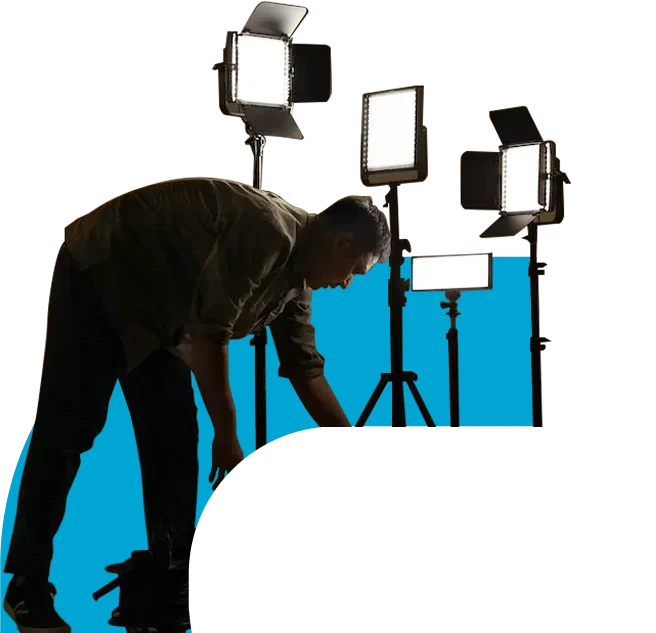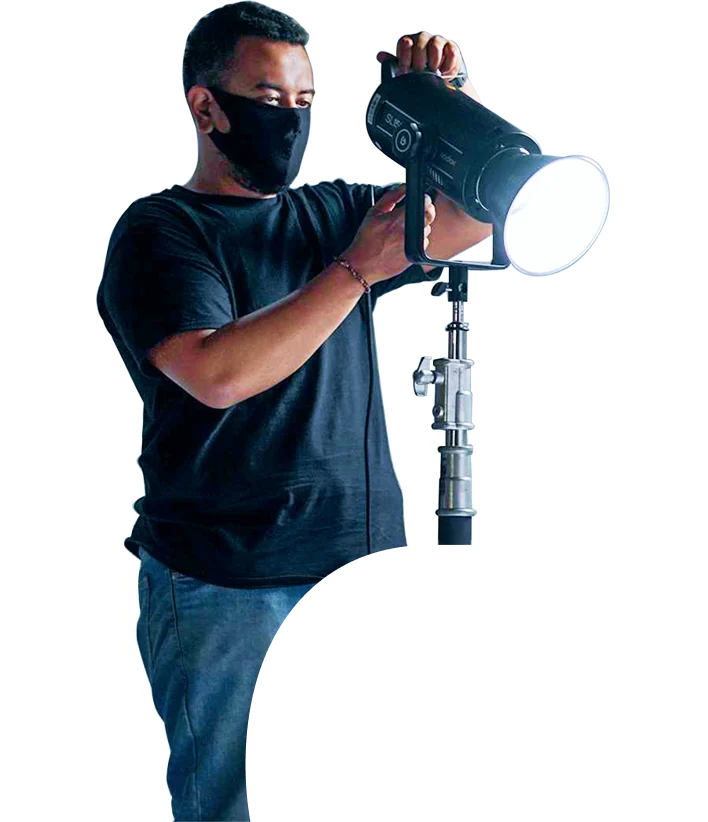BEST BOY
The best boy works closely with the gaffer, who leads the lighting team on a film set and works under the guidance of the cinematographer
In the world of filmmaking, a best boy plays a crucial role behind the scenes. The title might sound a bit odd, but it's a big-time job in the industry! The best boy assists the gaffer, who's in charge of the lighting department on a film set. They're like the gaffer's right-hand person, responsible for managing the lighting crew and equipment.
The best boy's tasks are diverse and essential as they handle the logistics of the lighting department, making sure everything runs smoothly. This includes organizing schedules, coordinating with other departments for power needs, and managing the lighting gear, from setting it up to maintaining and keeping it in top condition.
What's cool about being a best boy is that you get hands-on experience with high-tech lighting equipment and work closely with creative teams to bring the director's vision to life. It's a role that requires technical skills, attention to detail, and the ability to work efficiently in a fast-paced environment.
Starting as a best boy can be a stepping stone to higher positions in the lighting department or even other areas in film production. It's a job that offers a blend of technical expertise and creative collaboration, making it a fantastic choice for those passionate about the magic of filmmaking behind the scenes.


The best boy holds a key role in the lighting department, an important job that is crucial to making movies look just the way the director wants them to. The best boy works closely with the gaffer, who leads the lighting team on a film set and works at the behest of the cinematographer (or director of photography/DP).
As a best boy, you're responsible for managing the day-to-day operations of the lighting crew and equipment. This involves coordinating the crew's tasks, ensuring all the lighting gear is set up correctly, and handling the logistics of the department. You'll organize schedules, maintain the equipment, and collaborate with other departments for power needs, making sure everything runs smoothly.
What's exciting about this role is that you get to work with cutting-edge lighting technology and collaborate closely with creative teams. You'll help translate the director's vision into reality by manipulating light to create specific moods and atmospheres for scenes.
Starting as a best boy can be an excellent way to gain hands-on experience in the film industry. It's a job that combines technical expertise with teamwork and creativity. Plus, it can open doors to other roles in filmmaking (including gaffer or even a DP), offering a fantastic path for those passionate about the technical aspects of creating movie magic.
Becoming a Best Boy in filmmaking involves a mix of education, hands-on experience, and a professional work ethic. Start by learning about the basics of filmmaking, either by enrolling in courses or workshops that cover lighting techniques, electrical work, and the technical aspects of film production. Understanding the fundamentals is key, especially when it’s time to put what you’ve learned into practice.
Getting hands-on experience by working on film sets in entry-level positions is probably the most important thing you can do. Jobs like a lighting technician or a grip can give you valuable exposure to the workings of the lighting department and how film sets operate. Once you have a foot in one door, you can use connections made on the set to open other doors.
Demonstrate your dedication and eagerness to learn: volunteer for projects, assist on independent films, or seek internships in lighting departments to gain practical experience. Here is when you can master the technical side of lighting equipment. Familiarize yourself with various lighting fixtures, their functions, and how to set them up and maintain them properly.
Apart from technical expertise, it’s important to work on your “soft skills.” Communication, teamwork, and problem-solving are crucial in the film industry. Collaboration plays an enormous role in getting a movie made, so these soft skills need to be just as developed as your technical skills.

When it comes to most creative endeavors–including filmmaking–having a degree isn’t always a strict requirement. What matters most as a best boy is a combination of hands-on experience, technical skills, and a solid understanding of lighting techniques.
While formal education, such as a degree in film studies or electrical engineering, can provide valuable knowledge and foundational understanding, many best boys have reached their positions through practical experience and on-the-job training. The film industry highly values hands-on experience and expertise with lighting equipment over formal degrees.
However, having a relevant degree can offer advantages: it can provide a structured learning environment, teaching you technical skills, industry standards, and theory that can complement your practical experience. Additionally, a degree might open doors for entry-level positions or internships, allowing you to gain initial industry exposure.
So while a degree can be beneficial and may provide a solid foundation, it’s not always a mandatory requirement to become a best boy. Hands-on experience, technical expertise, networking, and a passion for lighting in filmmaking are key elements that often weigh more heavily in the film industry.
Becoming a best boy in filmmaking requires a blend of technical skills, teamwork, and a knack for problem-solving. A solid understanding of lighting equipment and its operation is crucial. Being adept at handling various lighting fixtures, knowing their functions, and being able to set up and maintain them is fundamental.
You will also need knowledge of electrical systems and safety protocols. Understanding power requirements, circuits, and electrical safety measures is vital for working with lighting setups on film sets. Being meticulous and paying close attention to detail is crucial in ensuring that lighting setups meet the specific requirements of each scene safely and securely.
On a film set, unexpected issues can arise with lighting equipment, so having the ability to troubleshoot problems quickly and find solutions under pressure is invaluable. Film sets can be dynamic environments: being adaptable to changing situations, schedules, and last-minute adjustments while maintaining focus on achieving the desired lighting setup is essential.
Collaborative skills can be just as important as technical skills in this fluid environment. You work closely with the gaffer and the lighting crew, requiring excellent teamwork, communication, and the ability to take direction effectively. And, while not a skill in the strictest sense, the job might involve lifting heavy equipment and working long hours on set, so having physical stamina is beneficial.
To become a Best Boy in filmmaking, learning through a hands-on approach is often the most effective method, with some formal education sprinkled in. Begin by taking entry-level positions on film sets. Jobs like a lighting technician or a grip offer valuable exposure to the workings of the lighting department. Learn by doing—observe, ask questions, and assist the crew to understand the technical aspects of lighting.
Consider enrolling in workshops or short courses focused on lighting techniques, electrical work, or film production. These courses–taken concurrently with working–can provide structured learning and complement your practical experience. The film industry evolves rapidly, so stay updated on new technologies, lighting trends, and industry standards.
Connecting with professionals already working in the industry while on the set is a key ingredient, too. You can also network at industry events, workshops, or in film-related communities to get insights, guidance, and potential mentorship opportunities. Apply for internships or apprenticeships with lighting departments or experienced Gaffers. These opportunities offer hands-on training, allowing you to learn from seasoned professionals in a real-world setting.
Volunteer or assist on independent films or student projects if you have free time or if you aren’t unable to find work on a “pro” set. These settings often offer more opportunities for hands-on involvement and a chance to take on responsibilities that might not be available in larger productions. If you want this to be your job, then treat it as such and take as much work as you can.
The time it takes to become a best boy in the filmmaking industry really depends on the individual. Are you a real go-getter, absorbing everything you learn, and hungry to learn more? It probably won’t take you as long as someone who views the job as a hobby or a mere stepping stone to something bigger.
So, there’s no fixed timeline. Gaining proficiency in the role of a best boy can take several years, starting with entry-level positions and gradually moving up the credit ladder will give you hands-on learning and skill development. The more experience you accrue, the better equipped you become for the job.
You can also look into formal education, like film studies or technical courses, related to lighting and electrical work. These programs provide foundational knowledge that complements on-the-job experience and can often be taken while you’re getting that practical work. It’s important to stay on the set in some capacity because that’s where connections and networking within the industry can streamline the process for you.
The demand for skilled professionals in the film industry can impact the speed of progression, too. Being in a location with a thriving film industry will provide more opportunities for growth and quicker advancement as opposed to the proverbial one-horse town. There’s no fixed timeline to becoming a best boy, but dedication, persistence, and a proactive approach can significantly speed up the path toward achieving this career goal.
In filmmaking, the roles of a best boy and a grip both play integral parts, yet they involve distinct responsibilities within the production crew. A best boy holds a crucial position within the electrical department while a grip operates within the camera and rigging department.
The best boy works closely with the gaffer, the head of the electrical department, managing the lighting crew, equipment, and logistics. Their role involves administrative duties like scheduling, coordinating with other departments, and ensuring that all lighting setups are executed efficiently. Additionally, they’re responsible for handling the maintenance and safety of electrical gear and ensuring that power sources are adequate for the production’s needs.
The grip handles various tasks related to camera support, rigging, and set assembly. Grips assist in setting up and moving camera equipment, constructing platforms or scaffolding, and managing tools like cranes, dollies, or mounts to achieve specific shots. Their responsibilities also extend to manipulating light modifiers, flags, and other materials to control lighting on set.
Both roles demand a keen understanding of the technical aspects of filmmaking and require adaptability, problem-solving skills, and the ability to work under pressure. They must be strong communicators and collaborators, and will often work in tandem setting up the lighting to help set the tone of a scene.
As a best boy in the electrical department of a film or television production, you’ll find yourself working with a diverse range of equipment that’s essential for creating captivating visual experiences on screen. Lighting equipment is at the core of your toolkit. This includes various types of lights such as tungsten, LED, and HMI lights, each with its own unique qualities and applications.
You’ll be responsible for understanding their specifications, like color temperature, wattage, and beam angle, to create the desired lighting setups. In addition to lights, grip equipment is crucial for modifying and controlling the light. This includes flags, diffusers, reflectors, and gels. Flags help control light spillage, diffusers soften harsh light, reflectors bounce light to fill in shadows, and gels alter the color temperature of lights for creative effects.
Electrical gear is another essential part of your inventory: Cables, power distribution boxes, dimmers, and various connectors are among the tools you’ll manage to ensure the safe and efficient functioning of the lighting setups. Knowledge of power sources and electrical safety standards is an absolute necessity to your role.
Specialized tools like light meters and color meters will assist you in measuring and adjusting light levels accurately. Your expertise in using these instruments will ensure that the lighting meets the director of photography’s vision for each scene. Your ability to manage and use this gear efficiently will contribute significantly to the success of the overall filming process.
What you can make as a best boy in the film industry can vary based on several factors, including experience, the scale of the production, location, and union affiliations. In general, a best boy’s salary ranges from $45,000 to $80,000 annually, but this figure can fluctuate significantly. Entry-level positions or those in smaller productions might fall within the lower end of the spectrum, while experienced best boys working on larger-scale projects or in major film hubs tend to command higher salaries.
Experience plays a significant role in determining pay. Those with a robust portfolio of successful projects and a solid track record often earn more due to their expertise and ability to handle complex tasks efficiently. Additionally, union affiliations, such as with the International Alliance of Theatrical Stage Employees (IATSE), can influence pay rates and provide benefits like health insurance and retirement plans.
Where you work is another critical factor affecting earnings. Best boys working in major entertainment hubs like Los Angeles or New York City generally earn higher salaries due to the higher cost of living and the abundance of larger-scale productions in these areas. Blockbuster films or high-budget TV series often allocate more substantial budgets for crew salaries, allowing best boys on such projects to earn more compared to smaller independent productions.
The film industry offers a multitude of job opportunities like these
Before you begin your job/career search think hard about what you want to do. What career our you passionate about? The good news is that as a Film Connection graduate you’ve already been exposed to most, if not all of these career choices. Once you figure out what career in the film industry turns you on, it’s time to put our Career Services and Job Placement Department to work for you.
Fill out the form to contact admissions and learn about your opportunities.

"*" indicates required fields
*Not all programs are available in every state. Consult an Admissions Representative to learn more.





Film Connection © 2025 | All Rights Reserved | Built with 💙 by DesignTork